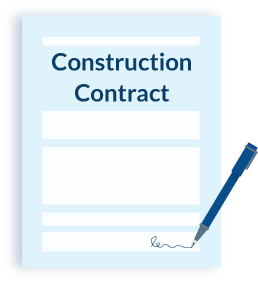
It’s important to understand the provisions of your construction contract, especially the ones that concern monetary damages. One of the most negotiated damage provisions is consequential damages, also known as indirect damages. Although related to other types of damage, this term is commonly misunderstood. That’s alarming, because consequential damages could make or break your business! Let’s take a deeper look at what consequential damages are and how they differ from other types of damages.
Damages When the Contract is Breached
Fundamental contract law states that when there is a material breach of a contract, the non-breaching party is entitled to compensation for losses that result from the breach. Compensation comes in the form of damages, of which there are two main categories: direct and consequential.
Direct, or general, damages are those that cover losses directly resulting from the breach. Direct damages will typically include any costs associated with the actual completion or correction of the work. Mainly, labor and materials costs. These are relatively easy to prove; the damages awarded should place the claimant in the same position they would have been, had the contract been appropriately executed.
But what about consequential damages?
Let’s Talk Breach
Construction Contracts: A Deep Dive on Breach of Contract
What are Consequential Damages?
Consequential damages arise when a party to a contract fails to hold up their duties under their contract, and the other party is damaged as a result.
Consequential damages extend beyond the direct damage caused, though. Instead, any damage incurred as a consequence of the failure to uphold the contract could be in play. Unless limited in the contract, consequential damages could extend far beyond the terms of the contract.
Example of consequential damages
Commonly, consequential damages can include things like property damage, personal injury, attorneys’ fee, lost profits/loss of use of space, and loss of reputation or good standing.
For example, let’s say a new hotel was constructed, and a plumbing contractor purposely overlooks some small issues to keep the job moving on schedule. Later, after the hotel opens, a large block of the hotel has leaky pipes and the water must be shut off — meaning no guests can stay there. The direct damages would be the costs for making the repairs — but there would be plenty of indirect or consequential damages: property damage from the water leak, loss of space, lost profits from guests being unable to stay, and possibly even loss of reputation if guests staying at the hotel are exposed to the leak. These are all consequential damages from the plumbing issue.
How to evaluate consequential damages
Consequential (indirect) damages are those that do not flow directly from the breach but instead are a secondary or indirect consequence of the breach. These occur when a party breaches a contract and is liable for all foreseeable losses incurred by the other party. To recover consequential damages, the claimant must prove they were (1) proximately caused by the breach and (2) were reasonably foreseeable at the time the parties entered into the contract.
Determining foreseeability is one challenge, yet the more difficult hurdle is proving the amount. Courts will not award damages unless the amount is proven within reasonable certainty. For owners, damages could include loss of use of the building, lost profits or increase in financing costs.
On the other hand, consequential damages for contractors could consist of lost opportunities, lost profits, or damages to their business reputation. Not only does the claimant need to plead these damages specifically, but they’ll also need to provide enough evidence to support their claim. This is a highly factual and time-consuming process.
Given the inherent difficulty in quantifying actual consequential damages, many parties opt to waive these in favor of liquidated damages, which provide the benefit of certainty. We’ll explore this and more types of damages in the next section.
How consequential damages differ from other damage types
Besides consequential damages, one of the most negotiated damage provisions is liquidated damages. There are also a few other types of damages related to breaches of contract, including incidental damages, punitive damages, and general damages.
Liquidated damages
Liquidated damages clauses provide a predetermined amount of money that may be recoverable if a party breaches the contract. Liquidated damages clauses will typically be tied to specific types of breaches, such as failure to complete work on time. These breaches are usually spelled out very clearly in the contract to avoid any disputes. In the situation described above, they’re typically set at a value or percentage per day after the completion date.
Consequential and liquidated damages should be mutually exclusive. Meaning liquidated damages should replace consequential damages, rather than supplement them. Additionally, liquidated damages should generally be preferred because the contractor can, at the very least, be aware of the extent of their exposure to damages.
Incidental damages
When a breach of contract occurs, incidental damages are the direct result of the breach (as opposed to the indirect results as with consequential damages). In the plumbing example from earlier, the cost of replacing the defective pipe in the hotel would be an incidental expense.
General damages
General damages can be harder to pin down — they refer to financially or materially intangible losses, which is why they’re also sometimes known as “non-economic damages.” One of the most common examples of general damages is the ongoing physical pain caused by an injury on the job — even after the material damages from a hospital bill are recovered.
Punitive damages
Punitive damages are damages that are assessed by the court during the legal process if the defendant in question is found to have been especially negligent or have purposely performed harmful actions. These are generally awarded in addition to other damages. As Cornell Law explains, these types of damages are not normally awarded during breach of contract claims, but it’s not impossible.
Download a free construction contract template that works on almost any project.Free contract template download
Consequential Damages Could be Substantial – Consider a Waiver
Many construction contracts will include a waiver of consequential damages. These will typically be waived in favor of liquidated damages for the benefit of the owner, and exclude any lost profits in favor of the contractor. However, having a mutual waiver of consequential damages benefits the contractor much more than it does the owner. It puts the contractor in the best position to control and manage risk to avoid liability. This is especially true if the improvement is a commercial building.
Think about it! A completed commercial building can generate higher revenues and profit margins than a contractor on any given project. The owner’s inability to use the structure can result in massive financial losses. So, comparatively speaking, the contractor would be on the hook for much more lost profits money than the owner would be for the contractor’s lost profits.
Establishing consequential damages is a delicate balancing act, and it’s one point that should be negotiated heavily before accepting the contract. Contractors view consequential damages waivers as leveling the risk between owner and contractor so that a contractor’s potential exposure is proportionate to its compensation under contract. Meanwhile, some owners believe contractors should be responsible for any possible damages caused by a failure to manage risk. So what gives?
Things to Keep in Mind When Negotiating the Contract
First, it’s important to inform the owner that any consequential damages resulting from completion delays can be addressed through liquidated damages. In many cases, having a set amount that will be due upon injury (via a liquidated clause) will be preferable! But, because consequential damages could benefit owners, and because the owner’s upside outweighs their risk, many owners will be reluctant to waive consequential damages.
Regardless, both parties to a given contract should seek to provide concrete definitions of what damages will be included and which will be waived if any. Specificity is key! Try to exclude at least any damages that would otherwise be covered by any applicable insurance policy. Another useful option is to set a cap on how much consequential damages can be awarded. Otherwise, these could be limitless based on the size and complexity of the project. And lastly, if the owner won’t budge on consequential or liquidated damages, maybe negotiate incentives into the agreement to make it worth your while.
With so many precise complexities to this contract negotiation process, it’s also never a bad idea to consider consulting a construction attorney to ensure you’re putting yourself in the best position possible.
Related Resources
- Defects in Construction: How to Identify and Avoid Them
- Construction Delay Claims: Types, Claims, and Defenses
- Construction Contracts: Watch Out for ‘No Damages for Delay’ Clauses


